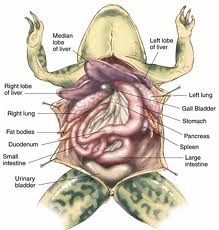Abstract
In this experiment, a frog was dissected to identify its major organs and organ systems. The purpose was to understand the anatomical structure and function of a frog's internal organs.
Introduction
The dissection of a frog provides valuable insights into its anatomy and physiology. Frogs are commonly used in biology laboratories due to their similarity to human anatomy and ease of study. This experiment aims to explore the major organs and organ systems of a frog, including the digestive, circulatory, respiratory, and excretory systems.
Experiment Details
The frog was dissected under a microscope to observe and identify its internal organs. Various tools such as scissors, forceps, and a scalpel were used for dissection.
Procedure
- Secure the frog onto the dissecting tray.
- Make an incision along the midline of the frog's ventral side, from the throat to the cloaca.
- Carefully peel back the skin and muscle layers using forceps and scissors to expose the internal organs.
- Identify and remove each organ systematically, starting with the digestive system.
- Observe and note the structure and function of each organ.
- Record observations in a table.
- Dispose of the frog's remains properly.
Observations and Calculations
Observations were recorded for each organ's appearance, size, and position within the body. No calculations were performed in this experiment.
 |
| Frog Dissection |
Conclusion
The dissection of the frog provided a comprehensive understanding of its internal anatomy. The major organs and organ systems were successfully identified, contributing to our knowledge of vertebrate biology.
Precautions
- Wear gloves and safety goggles to protect against biohazards.
- Dispose of biological waste properly according to laboratory guidelines.
- Handle dissecting tools with care to avoid injury.
- Ensure proper ventilation in the laboratory to minimize exposure to chemical odors.
Short Questions with Answers
-
Question 1: What is the function of the frog's heart?
Answer: The frog's heart pumps blood throughout its body, delivering oxygen and nutrients to tissues. -
Question 2: Identify the organ responsible for respiration in a frog.
Answer: The lungs are the primary respiratory organ in a frog, facilitating gas exchange. -
Question 3: Which organ in a frog stores bile for digestion?
Answer: The gallbladder stores bile produced by the liver in a frog. -
Question 4: What is the function of the frog's liver?
Answer: The liver in a frog aids in digestion, detoxification, and the production of bile. -
Question 5: Name the organ that filters waste from the frog's blood.
Answer: The kidneys filter waste products from the blood in a frog. -
Question 6: Identify the organ responsible for producing urine in a frog.
Answer: The kidneys produce urine by filtering waste from the blood in a frog. -
Question 7: What are the functions of the frog's intestines?
Answer: The intestines in a frog are responsible for digestion and absorption of nutrients. -
Question 8: Name the organ that stores urine temporarily in a frog.
Answer: The urinary bladder stores urine temporarily in a frog. -
Question 9: Identify the organ that produces digestive enzymes in a frog.
Answer: The pancreas produces digestive enzymes in a frog. -
Question 10: What is the function of the frog's spleen?
Answer: The spleen in a frog plays a role in immune response and blood storage. -
Question 11: Name the organ responsible for storing food in a frog.
Answer: The stomach stores food temporarily for digestion in a frog. -
Question 12: Identify the organ that secretes digestive juices into the small intestine.
Answer: The pancreas secretes digestive enzymes into the small intestine for digestion. -
Question 13: What is the role of the frog's urinary system?
Answer: The urinary system in a frog helps regulate water balance and removes waste from the body. -
Question 14: Name the organ system responsible for coordinating movement in a frog.
Answer: The muscular system is responsible for coordinating movement in a frog. -
Question 15: Identify the organ system responsible for processing sensory information in a frog.
Answer: The nervous system processes sensory information in a frog. -
Question 16: What are the components of the frog's circulatory system?
Answer: The circulatory system in a frog consists of the heart, blood vessels, and blood. -
Question 17: Name the organ system responsible for producing eggs or sperm in a frog.
Answer: The reproductive system is responsible for producing eggs or sperm in a frog. -
Question 18: Identify the organ system responsible for supporting and protecting internal organs in a frog.
Answer: The skeletal system supports and protects internal organs in a frog. -
Question 19: What is the function of the frog's endocrine system?
Answer: The endocrine system in a frog regulates various physiological processes through hormone secretion. -
Question 20: Name the organ system responsible for filtering blood and removing toxins in a frog.
Answer: The excretory system filters blood and removes toxins through organs like the kidneys and skin in a frog.
Multiple Choice Questions with Answers
-
What is the primary function of the stem in a mustard plant?
- a) Storage of nutrients
- b) Photosynthesis
- c) Support and transport
- d) Reproduction
Answer: c) Support and transport
-
Which part of the mustard plant is responsible for gas exchange?
- a) Stem
- b) Leaf
- c) Root
- d) Flower
Answer: b) Leaf
-
What is the function of the root in a mustard plant?
- a) Photosynthesis
- b) Absorption of water and nutrients
- c) Support
- d) Reproduction
Answer: b) Absorption of water and nutrients
-
Which structure of the mustard plant is directly involved in reproduction?
- a) Stem
- b) Leaf
- c) Flower
- d) Root
Answer: c) Flower
-
What is the function of the fruit in a mustard plant?
- a) Absorption of water
- b) Protection of seeds
- c) Photosynthesis
- d) Gas exchange
Answer: b) Protection of seeds

